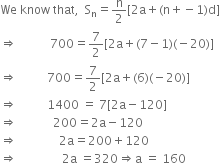 Short Answer Type
Short Answer TypeFind the sum of first 51 terms of an AP whose second and third terms are 14 and 18 respectively.
If the sum of first 7 terms of an AP is 49 and that of 17 terms is 289, find the sum of first n terms.
Show that a1 , a2 , . . ., an, . . . form an AP where an is defined as below :
an = 3 + 4n
Show that a1 , a2 , . . ., an, . . . form an AP where an is defined as below :
an = 9 – 5n
If the sum of the first n terms of an AP is 4n – n2 , what is the first term (that is S1 )? What is the sum of first two terms? What is the second term? Similarly, find the 3rd, the 10th and the nth terms.
Since each prize is Rs. 20 less than its preceding prize, therefore, the values of the seven successive cash prizes will form an A .P.
Let the first prize be Rs. a. Then, Successive prize = Rs. (a – 20), Rs. (a – 40),
Rs. (a – 60)..........Here, first term = a
Common difference = (a – 20) – a = –20 n = 7 and Sn = 700
Hence value of first prize = Rs. 160, and successive prizes are
Rs. (a – 20), Rs. (a – 40), Rs. (a – 60) ...
i.e. Rs. (160 – 20), Rs. (160 – 40), Rs. (160 – 60)...
i.e. Rs. 140, Rs. 120, Rs. 100 ...
